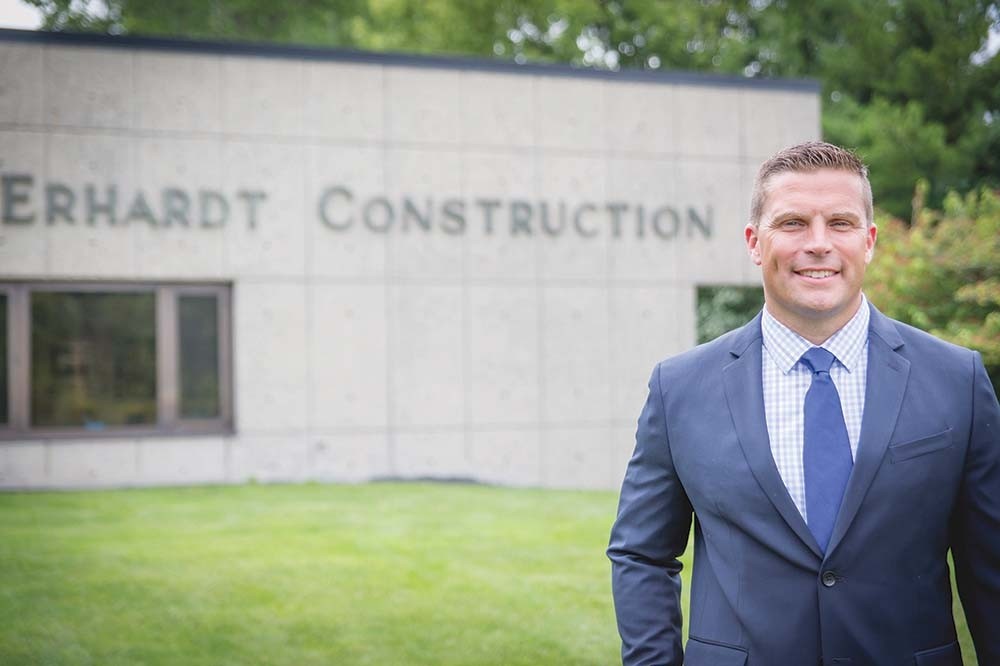
Ada-based Erhardt Construction Co. focuses on a variety of market sectors — including industrial, higher education, senior living, places of worship, office and retail — and has intentionally diversified to be better positioned when one market slows down. While CEO Ben Wickstrom is concerned about some industry trends he expects to see in 2021, including a shrinking backlog of projects, he is still mostly optimistic about a gradual rebound starting around midyear. He also hopes the pandemic underscores the value of revenue to municipalities that helps drive construction projects, and plans to closely watch productivity on projects amid new worksite regulations.
What are you looking forward to in 2021?
At the forefront is getting this thing (COVID-19)under control. That’s what I’m looking forward to. Beyond that, I’m looking forward to what we’ve learned this year and keeping things that have worked well and getting everyone back in the office.
I’ve been really pleased at how productive everyone has proven they can be remotely, but at the same time, it’s reinforced how much we like to be together at work.
Many developments were delayed this year because of the pandemic. Do you see construction projects increasing in the new year?
I think it will probably be in the second or third quarter. I’m optimistic about stabilization in the first quarter, then trending back a little bit to modest growth, but I don’t think we’ll get back to 2019 levels yet. There won’t be an immediate turnaround, but things will start to pick back up, and they have to. We’re starting to see some good news about things turning around.
The average national backlog has decreased and the Architectural Billings Index has softened. Does this concern you going into 2021?
It does concern me — that’s a good leading indicator for our industry. Our backlog is healthy enough to get us through 2021, but in 2021 we will definitely still have room to grow.
Several factors in 2020, including COVID-19, caused construction materials to increase in price and volatility. Do you see this being an issue in 2021?
I don’t think the volatility will be at the same level. I can’t predict what it’s going to do but I think as time goes on and the supply chain adapts to the new realities, the volatility will smooth out. It has been getting better.
There’s also a lot of factors to materials pricing besides the pandemic. For example, all the forest fires on the West Coast had a big impact on lumber. While everyone is thinking about the pandemic, all the other influences are still there as well.
What other trends do you expect in 2021 that haven’t gotten much discussion?
I’m concerned about a loss in revenue to state and local governments. I think it’s something that needs to get some attention. Construction spending on public projects and infrastructure is a big deal for our industry and our community.
Do you foresee any improvements on the talent shortage that the construction industry has been facing?
Right now is a perfect time to find people. For Erhardt, talent is still at the forefront of what we do. It’s the slower times when we double down on talent. It’s a long-term reality of our industry because when these projects and jobs do come back, the need for talent in construction will still be there and is there now.
How will the pandemic affect how your company operates long term?
I’m keeping a really close eye on productivity. When construction was allowed to return in May, there was a lot of talk about how the increased protocols and (U.S. Centers for Disease Control and Prevention) guidelines were going to slow down the pace of construction. I was really interested to see how that would play out.
When you talk about things like reducing crew size or virus-related things, I’m keeping a really close eye on what that does for productivity. In some cases, it increases productivity because it eliminates stacking trades. Trades are not stacked on top of each other as much under these new guidelines, and being less condensed and increasing work space can result in increased productivity when done the right way. That’s something I’m going to keep tracking.



